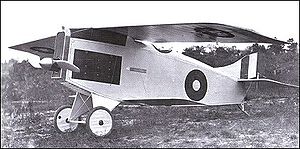- Christmas Bullet
-
Christmas Bullet c. 1918 Role scout National origin United States Manufacturer Christmas Aeroplane Company Designer William W. Christmas, Vincent Burnelli First flight January 1919[1] Status Destroyed Number built 2 The Christmas Bullet, later known as the Cantilever Aero Bullet (sometimes referred to as the Christmas Strutless Biplane), was an American single-seat cantilever wing biplane. It is considered by many to be among the worst aircraft ever constructed.[2]
Contents
Design and development
Dr. William W. Christmas (1865-1960) [3] , who had no experience in aircraft design or aeronautical work, claimed to have built an aircraft of his own design in 1908 that was lost in a crash.[4] After a second aircraft was supposedly built, called the Red Bird, later modified into the Red Bird II, Christmas founded the Christmas Aeroplane Company based in Washington, DC, in 1910. No evidence beyond his own claims has ever been found for the existence of either of these aircraft. By 1912, the company became the Durham Christmas Aeroplane Sales & Exhibition Company and later the Cantilever Aero Company after moving to Copiague, NY, in 1918.[4]
Christmas convinced two brothers, Henry McCorey and Alfred McCorey, to back him. They then paid a visit to the Continental Aircraft Company, of Long Island, where Christmas convinced management that his planned aircraft would be the key element in an audacious plot to kidnap Kaiser Wilhelm II of Germany. Two designs were proposed, a single-seat "scout" and a three-place "fighting machine."[4]
The single-seat "Christmas Bullet" featured an all-wood construction with a veneer-clad fuselage, although despite his claims to the contrary, neither design feature reduced aerodynamic drag, nor was he among the first to use this method of construction; the majority of German World War I-era two-seater aircraft used for bombing and reconnaissance were similarly constructed. The "Bullet" was powered by a prototype Liberty 6 engine. Although the US Army had been persuaded to loan an engine, the proviso was that the prototype engine was to be fitted into an airframe for ground testing only.[5]
The design had a serious flaw in that it lacked any kind of struts or braces for the wings, with Christmas' insisting that they should be flexible. Control of the aircraft was meant to be achieved by applying the technique of wing warping to its tail surfaces.[4] Although the Chief Engineer at Continental, Vincent Burnelli, tried to institute changes, the "Christmas Bullet" was completed with the original design features intact. Construction materials were scrounged from available wood and steel stock and were not "aircraft grade", which was also a concern to Burnelli.[4]
Operational history
On its maiden flight in January 1919, the wings of the "Bullet" peeled from the fuselage and the aircraft crashed[2], killing the pilot, Cuthbert Mills.[4] The destruction of the prototype Liberty engine was never revealed to the US Army and a second Bullet was built powered by an Hall-Scott L-6 engine.[2] The second prototype was also destroyed on its first flight, again with the loss of the test pilot, Lt. Allington Joyce Jolly. Jolly is buried in the Cropsey Cemetery in Cropsey, Illinois. The project was abandoned before its United States Army Air Service (USAAS) evaluation.[1]
Following the crash of the second Bullet, Christmas continued to campaign for more funding for further projects, seeking out private and government sources, claiming "hundreds" of patents or patent submissions based on his aeronautical research. His far-fetched assertions were proved untrue but he did apparently sell his unusual wing design to the US Army ("or so he claimed").[2]
A contemporary technical description with photographs and drawings appeared in Flight, 13 February 1919, claiming that "it would seem that such construction would result in a low factor of safety, but the designer claims a safety factor of seven throughout".[6]
Specifications (First prototype)
Data from [1]
General characteristics
- Crew: 1
- Length: 21 ft 0 in (6.40 m)
- Wingspan: 28 ft 0 in (8.53 m)
- Wing area: 170 ft2 (15.79 m2)
- Empty weight: 1,820 lb (826 kg)
- Gross weight: 2,100 lb (953 kg)
- Powerplant: 1 × Liberty 6, 185 hp ( kW)
Performance
- Maximum speed: 175 (anticipated) mph (282 km/h)
- Range: 550 miles (885 km)
- Service ceiling: 14,700 ft (4,481 m)
References
- Notes
- ^ a b c Angelucci 1987, p. 94.
- ^ a b c d Winchester 2005, pp. 256–257.
- ^ http://encyclopedia.gwu.edu/gwencyclopedia/index.php?title=Christmas%2C_Dr._William Chrstimas, Dr. William in Historical Encyclopedia, George Washington University, retrieved 2011 06 24
- ^ a b c d e f Gilbert 1978, pp. 41–49.
- ^ "Christmas Bullet - experimental". Virtual Aircraft Museum. Retrieved: 16 July 2009.
- ^ "The Christmas Strutless Biplane." Flight, Volume XI, Issue 7, No. 529, 13 February 1919, pp. 207–208.
- Bibliography
- Angelucci, Enzo. The American Fighter from 1917 to the present. New York: Orion Books, 1987. ISBN 978-5-550-23557-7.
- Gilbert, James. The World's Worst Aircraft. Philadelphia, PA: Coronet Books, 1978. ISBN 0-340-21824-X.
- Winchester, Jim. The World's Worst Aircraft: From Pioneering Failures to Multimillion Dollar Disasters. London: Amber Books Ltd., 2005. ISBN 1-904687-34-2.
External links
Lists relating to aviation General Aircraft (manufacturers) · Aircraft engines (manufacturers) · Airlines (defunct) · Airports · Civil authorities · Museums · Registration prefixes · Rotorcraft (manufacturers) · TimelineMilitary Accidents/incidents Records Categories:- United States fighter aircraft 1910–1919
- United States experimental aircraft 1910–1919
- Aircraft manufactured by the United States
Wikimedia Foundation. 2010.

